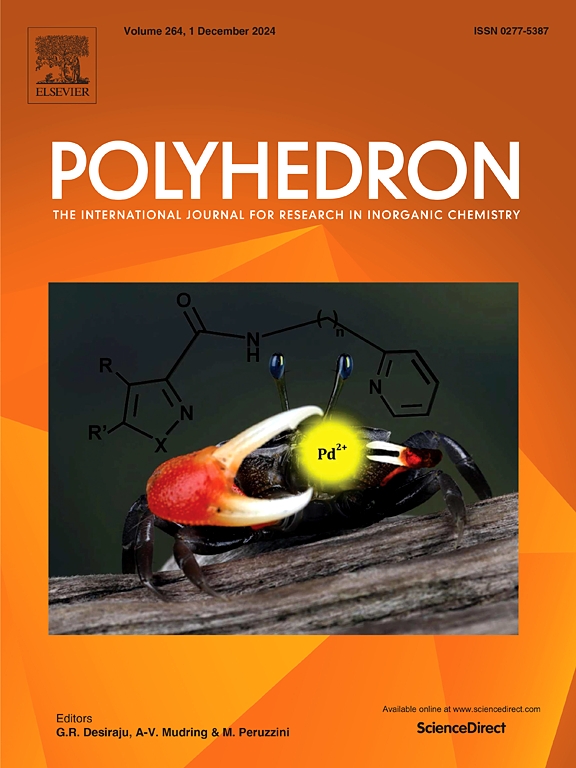Size-dependent magnetic properties and anisotropy in biocompatible Co2B nanoparticles: enhancing SAR efficiency for magnetic hyperthermia therapy
IF 2.4
3区 化学
Q2 CHEMISTRY, INORGANIC & NUCLEAR
引用次数: 0
Abstract
This study investigates the magnetic and thermal properties of cobalt boride (Co2B) nanoparticles, synthesized using arc-melting and ball-milling techniques, for potential use in self-controlled magnetic hyperthermia. Ball milling (BM) effectively reduced crystallite size, significantly affecting key magnetic properties such as saturation magnetization and coercivity, both of which showed strong size dependence. The nanoparticles exhibited a Curie temperature within the therapeutic range (315–320 K), making them ideal candidates for hyperthermia-based cancer treatment. The effective anisotropy constant and exchange stiffness constant also derived from experimental coercivity values using the single domain (SD) particle size limit. The specific absorption rate (SAR) reached a maximum of 10 W/g for nanoparticles with an average crystallite size of 34 nm, demonstrating superior heating efficiency compared to other magnetic nanoparticles. Hemolysis as well as WST-8 assays (water-soluble tetrazolium salt) confirmed the biocompatibility of Co2B nanoparticles, and encapsulation within liposomal formulations further reduced cytotoxicity. These findings underscore the potential of Co2B nanoparticles for biomedical applications, particularly in magnetic hyperthermia therapy.

生物相容性Co2B纳米颗粒的大小依赖性磁性和各向异性:增强磁热疗的SAR效率
本研究研究了采用电弧熔化和球磨技术合成的硼化钴(Co2B)纳米颗粒的磁性和热性能,该纳米颗粒有望用于自控磁热疗。球磨(BM)有效地减小了晶粒尺寸,显著影响了关键的磁性能,如饱和磁化强度和矫顽力,两者都表现出强烈的尺寸依赖性。纳米颗粒在治疗范围内(315-320 K)表现出居里温度,使其成为基于高温的癌症治疗的理想候选者。有效各向异性常数Keff和交换刚度常数Aexc也由单畴(SD)粒径极限下的实验矫顽力值推导得到。在平均晶粒尺寸为34 nm时,纳米颗粒的比吸收率(SAR)达到了10 W/g的最大值,与其他磁性纳米颗粒相比,显示出更高的加热效率。溶血和WST-8试验(水溶性四氮唑盐)证实了Co2B纳米颗粒的生物相容性,并且在脂质体制剂中包封进一步降低了细胞毒性。这些发现强调了Co2B纳米颗粒在生物医学应用方面的潜力,特别是在磁热疗方面。
本文章由计算机程序翻译,如有差异,请以英文原文为准。
求助全文
约1分钟内获得全文
求助全文
来源期刊

Polyhedron
化学-晶体学
CiteScore
4.90
自引率
7.70%
发文量
515
审稿时长
2 months
期刊介绍:
Polyhedron publishes original, fundamental, experimental and theoretical work of the highest quality in all the major areas of inorganic chemistry. This includes synthetic chemistry, coordination chemistry, organometallic chemistry, bioinorganic chemistry, and solid-state and materials chemistry.
Papers should be significant pieces of work, and all new compounds must be appropriately characterized. The inclusion of single-crystal X-ray structural data is strongly encouraged, but papers reporting only the X-ray structure determination of a single compound will usually not be considered. Papers on solid-state or materials chemistry will be expected to have a significant molecular chemistry component (such as the synthesis and characterization of the molecular precursors and/or a systematic study of the use of different precursors or reaction conditions) or demonstrate a cutting-edge application (for example inorganic materials for energy applications). Papers dealing only with stability constants are not considered.
 求助内容:
求助内容: 应助结果提醒方式:
应助结果提醒方式:


